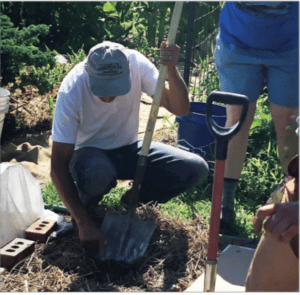By Nadie VanZandt
Editor’s note: Nadie VanZandt is a UVM Extension master gardener from Panton.
During the early months of the pandemic, gardening and other domestic hobbies saw an unprecedented revival. Trends come and go, but in gardening, one that seems here to stay is the no-dig, also called the no-till method.
Touted by gardening gurus including the United Kingdom’s Charles Dowding as easy, quick and ecologically friendly, no-dig is a practice that foregoes the use of the rototiller and shovel. It seems too good to be true until you begin to dig into it and discover its merit.
During the decade-long Dust Bowl in the 1930s, massive erosion and crop failures led farmers and agricultural scientists to investigate soil conservation and better farming practices.
In 1943, Edward H. Faulkner, an agricultural extension agent in Ohio, published a controversial book, “Plowman’s Folly,” in which he argued against plowing, a practice he claimed to be destructive. At the time, his ideas were ridiculed, and it was only posthumously that soil scientists recognized the genius behind the concept. Today, Faulkner, who died in 1964, is considered the grandfather of the no-dig movement.

The no-dig method is a useful gardening solution in the fall.
Other proponents of the no-dig method followed in the 1950s and 1970s. Ruth Stout, a free-spirited American gardener, who took off her clothes to garden naked, used the no-dig method out of desperation and described her technique in her famous book, “The Ruth Stout No-Work Gardening Book,” Similarly, the Japanese farmer-philosopher Masanobu Fukuoka promoted his concept of natural gardening through no-till practices.
“Plowman’s Folly” was reprinted in 2015, and 72 years after its original publication date, Faulkner’s once-ridiculed idea is taking the gardening world by storm.
No-dig means just that. No digging, no tilling, no plowing. It simulates the natural renewal of plant life that occurs on a forest floor. No-dig works on all soil types and results in prolific vegetables or flowerbeds. No sore back, no shovel, et voilà, your garden bed is ready for planting.
You can prepare a no-dig bed anytime, including this fall before the ground freezes. Instead of tilling to aerate and loosen the soil, all you need to do is to mow the grass, cut plants to soil level and remove large debris.
Next, smother the ground with flattened, brown cardboard boxes or sheets of non-glossy newspaper. Remove all plastic tape and shipping labels. Overlap the sheets to completely block sunlight over the area. After thoroughly wetting down the cardboard, follow with a 6-inch application of quality compost. The compost will further decompose and function both as soil nutrients and mulch.




